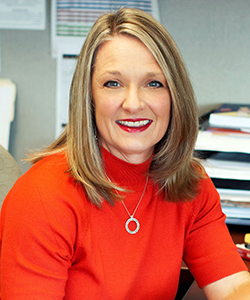August 28, 2023

A spoonful of sugar may help the medicine go down. But if your doctor sugarcoats the truth, it can leave a bad taste in your mouth — and impact your health.

Your relationship with your provider is the foundation for your health care, according to Dr. Lea Brandt, director of the MU Center for Health Ethics. Finding ways to build stronger patient-provider relationships is especially important to Dr. Brandt. As part of an academic health system, she sees complex cases that require open and clear communication between the patient and the provider. But that communication can be difficult.
“We find the more complex and critical the situation is, the harder it can be to communicate, and patients become confused and frustrated,” she says. “So we’re studying and implementing techniques and strategies that will help us close those gaps in communication and understanding.”
Health care providers are humans too and may think they’re sparing you by minimizing potentially severe health issues or glossing over uncomfortable topics. But skirting the truth in this way — often referred to as “brightsiding” — can jeopardize your health and the patient-provider relationship.
“That relationship needs to be built on trust,” Dr. Brandt says. “You have to feel like you’re getting the information you need and that your doctor has your best interest at heart.”
Here’s what you need to know to get the most out of your next medical appointment:
What is brightsiding?
“Brightsiding” stems from the phrase, “look on the bright side.” It’s the practice of steering someone toward the positive and away from anything that feels dark or foreboding. But it often involves sugarcoating reality so the truth gets distorted or hidden. When brightsiding happens in a health or medical setting, it can be toxic.
Examples of brightsiding in health care include:
- Downplaying the severity of the situation: Such as saying, “We should keep an eye on your weight” to someone with obesity.
- Providing false hope: “I’m 99% sure it’s nothing, but let’s get it checked out.”
- Shrugging off a patient’s concerns: “It could just be stress causing your symptoms.”
Health care professionals don’t knowingly use brightsiding or twist the truth intentionally. It’s often the opposite — they may be unconsciously trying to avoid:
- Admitting they don’t have an answer or diagnosis
- Conflict with patients or their families
- Overwhelming a patient with too much information
- Making a patient feel uncomfortable
- Upsetting or scaring patients
Negative effects of brightsiding
Doctors may think they’re sparing your feelings by softening a medical blow. But it often does more harm than good.
“Brightsiding can cause harm if the patient walks away and is unclear about the severity of the situation,” Dr. Brandt says. “It can rob them of the ability to make informed decisions regarding their care and keep them from truly partnering with their medical team to identify the best options moving forward.”
Tips for avoiding brightsiding
Even though it may not be intentional, brightsiding occurs regularly in the health system, according to Dr. Brandt. “We have to go into medical encounters recognizing that it happens,” she says. “It’s not intended to be harmful, but it often is.”
The problem is that there are no telltale signs of brightsiding. The only way to ensure it isn’t happening is to increase the dialogue with your health care providers and encourage open and honest communication.
Dr. Brandt says there’s no perfect formula for avoiding brightsiding, but she recommends that you:
1. Be clear about the information you want
Dr. Brandt says preventing brightsiding begins with an honest conversation with your doctor. Stress the importance of a partnership. Let them know you want a clear understanding of what's going on to make better health decisions for yourself.
“By saying those things clearly to your physician and your team, you're much more likely to get the full picture of your condition,” Dr. Brandt says.
2. Ask for the “why”
If you’re unsure about your provider’s assessment or concerned they aren’t sharing all the information with you, don’t be afraid to ask how they came to that conclusion.
Dr. Brandt suggests asking your doctor why they don’t think the issue is concerning or why they are making that recommendation. Encourage them to talk you through their thinking.
3. Repeat information back to the doctor
Gathering all the facts is critical if you want to avoid brightsiding. To ensure you and your provider are on the same page, repeat the information as you heard it. Tell them what you think is happening. That way, your doctor can fill in any holes for you.
“It’s important that you have accurate information,” Dr. Brandt says. “Then you can decide if you’re on board with the recommended clinical pathway given your unique situation and needs.”
4. Don’t be afraid to ask for more information after the appointment
It happens all the time — you come up with questions for the doctor or doubt the information you received after you’ve left the office. Or maybe you have questions during the appointment but are hesitant to speak up.
“When we don’t have all the information we need, we create a negative story and tend to think the worst,” Dr. Brandt says. “Before you go to that negative narrative, ask yourself, ‘What do I not understand? What are the questions I have that are causing these concerns?’ It’s completely appropriate to ask questions after the appointment is over.”
There are several ways to get your follow-up questions answered, including:
- Reaching out through the patient portal to ask your question.
- Speaking to someone at the office, such as a nurse or other team member.
- Scheduling a follow-up visit to take place in person or virtually.
5. Pivot to a new provider when necessary
Some doctors are better communicators than others. If you’ve expressed your wishes for clear communication and don’t feel heard, consider finding a new provider.
“I appreciate a physician who uses narrative medicine — they might ask, ‘What do I need to know about you to best take care of you?’” Dr. Brandt says. “To me, that's the indication of a great physician.”
Navigating toxic positivity as a caregiver or parent
Brightsiding can be hard to identify in a pediatric appointment. Pediatricians need to be considerate when communicating information simultaneously to a child and a parent or caregiver.
“It’s appropriate for doctors to limit the information they provide children based on where they're at in their development, what they can absorb and what they're emotionally ready for,” Dr. Brandt says. “And they may be inclined to soften the information they deliver to parents, especially if they are in a heightened emotional state.”
To ensure you are getting clear and complete information from your pediatrician, parents need to:
- Have the conversation privately: Ask the pediatrician to talk with you away from your child. The doctor is more likely to be open and honest when speaking with adults.
- Keep hope in check: False hope is attractive when talking about your child’s care, Dr. Brandt notes. Ask the doctor to help you set realistic expectations.
Next Steps and Useful Resources
- Need a conversation starter? 5 Questions to Ask When You (or Your Child) Are Sick


